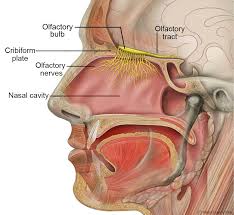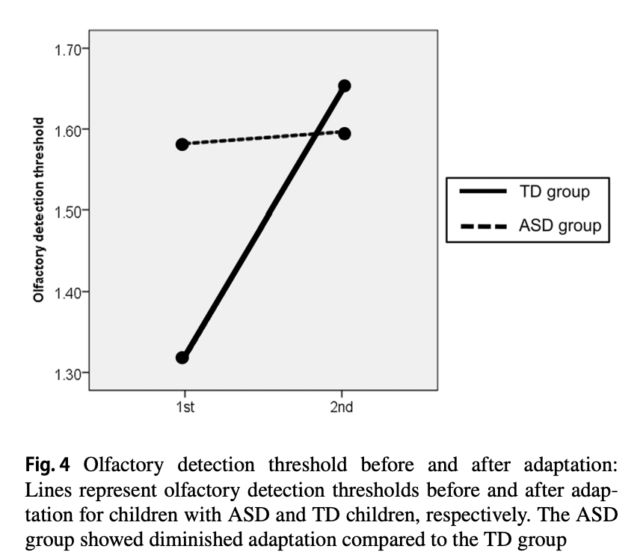Olfactory adaptation and autism

The Diagnostic and Statistical Manual of Mental Disorders, 5th edition (DSM-5) includes sensory alterations as one of the four characteristics of restricted / repetitive behavior of people with autism spectrum disorder (ASD). It defines this symptom characteristic as a «hyper- or hyporeactivity to sensory inputs or an unusual interest for sensory aspects of the environment». People with ASD have more symptoms of altered sensory modulation than normotypic individuals or those with intellectual disability. The issue is important because these anomalies in the senses can be an important source of stress and anxiety for children and adults with ASD. Among alterations of sensory modulation, olfactory problems allow to clearly distinguish people with ASD from people with other developmental disorders. Many times we are not aware of the impact that smell has on our lives but the differences in the smell of individuals with ASD can contribute to restrictive and unbalanced diets and to feel uncomfortable in some places where there are characteristic odors. There are also reports and scientific articles that indicate problems in the smell of people with ASD and that the severity of this symptomatology is a predictive factor of difficulties in social interaction in children with autism.
Adaptation is a key feature of neuronal systems and can be defined as a short-term reduction in the response or sensitivity of neurons after prolonged exposure to a stimulus to which these neurons are sensitive. An example of olfactory adaptation is when we enter a room without ventilation, at first we notice that atmosphere but after a few seconds we no longer perceive it, our olfactory system has adapted. A product of olfactory adaptation is that we cannot smell our own perfume. An example of tactile adaptation is when we dress in the morning, at first we notice the fabrics or the labels of the clothes but after a few seconds we are no longer aware, our touch receptors have adapted and we do not notice that we have put on something and is rubbing steadily with our skin. Adaptation allows us to adjust our response to changes in the environment, we notice the initial difference (something that was not and is now or vice versa and also something that has increased or decreased) but if it is not something important in a short time we stop notice it and we are ready for new sensations. In fact, the olfactory adaptation serves to facilitate the perception of olfactory stimuli that are novel or that are changing in intensity. It also increases the reaction time and decreases the behavioral response to olfactory stimuli. Thus, although the stimulus remains equally present, in a certain way it is ignored by our nervous system.

There are studies that indicate that adaptation is altered in people with autism. This may involve discomfort, anxiety and abnormal behavior. Olfactory adaptation, also known as “nose blindness” can be defined as “prolonged or repeated exposure to an odorant that typically leads to a reduction in the perceived intensity of an odor and an increase in the detection threshold”. The effects of adaptation can be measured using electrophysiology, neuroimaging or analyzing psychophysiological changes in behavior in perception. The process of olfactory adaptation depends on different variables such as the concentration of odorant substance used for adaptation, the duration of adaptation and the similarity of the odorant used for adaptation and that used for a new stimulation. At the behavioral level, the response to a novel stimulus after the termination of an olfactory adaptation process depends on the time interval between the end of the exposure to the odorant that caused the stimulation and the subsequent stimulation with the second odorant. It has also been seen that adaptation depends on the relevance of the substance, people show less adaptation when they believe that smell is important, in a way it is as if the brain wants to keep track on its presence. Olfaction is important for survival and so many of the bad smells go together with the risk of diseases (stagnant water), hazards (gas) or poisoning (food in poor condition). On the other hand, smell is also linked to pleasure and hedonism also influences the olfactory adaptation, which contributes to the comfort of a person with the environment that surrounds him. For example, if children play in a park where they smell a chemical, they do not usually stay in that area because the smell of the chemical makes them feel disgusted. However, if they return repeatedly to that area they begin not to notice the difference and feel at ease due to the adaptation of their sense of smell. Adaptation helps them stay where they enjoy.
Since olfaction and olfactory adaptation are important to feel comfortable in a given environment, they may be important for ASD where inclusion in an environment is less than in normotypic people. The first study on olfactory adaptation in people with ASD was made by Tavassoli and Baron-Cohen in 2012 1 and found no differences between people with ASD and normotypic. Other studies with topics related to smell and adaptation have generated inconsistent results. One part of the problem is the methodology: odors remain in the environment, which makes measurements difficult. In addition, although we have a concentration of a molecule odorant in a bottle, various conditions (temperature, distances) can affect the volatility of the substance and make irregular the concentrations that reach the olfactory receptors in the nose.
The group of Kumazaki has published in 2019 in the Journal of Autism and Developmental Disorders a study 2 on olfactory adaptation in children with ASD versus normotypic controls that solves these problems. They have used a system developed by them that they have called Fragance Jet for Medical Checkup that uses an odorant pulse ejection system similar to that of an inkjet printer. This system projects small drops of a fragrance and uses very little quantities which makes their permanence in the environment very limited. Another advantage is that they use isoamyl acetate, while in the Tavassoli and Baron-Cohen study they employed n-butanol. Alcohols such as butanol stimulate not only the olfactory system but also the trigeminal nerve. This can be confused due to the simultaneous stimulation of two sensory routes. On the other hand, isoamyl acetate, which smells like banana, has other advantages: it is well preserved, it is cheap and easy to obtain. The Japanese researchers excluded participants who had an organic condition of smell, nasal blockage due to sinusitis or viral infection, acute respiratory infection, premenstrual syndrome or presence in the medical record of head injuries or use of illicit substances. They also excluded boys with ASD who presented syndromic autism (FMR1, Rett syndrome and Shank 3). Inclusion criteria were diagnosis of ASD according to DSM-5 criteria, age between 9 and 15 years and intelligence quotient ≧ 70. The study group was finally 9 children with ASD and 9 normotypic, the 9 participants with ASD were boys while of the normotypic, 6 were boys and 3 girls. Since the adaptation is different if the smell is considered pleasant or unpleasant the researchers verified, using a Likert scale, that all the participants were familiar with the smell of banana and that they did not find it particularly pleasant or unpleasant.

The statistical study (ANOVA) confirmed that the normotypic group showed greater adaptation than the group with ASD. The sensitivity to the first exposure was higher in the normotypic (1.32 ± 0.27), than in those with ASD (1.58 ± 0.41). In the ASD there was hardly any adaptation and the value in the second exposure (1.60 ± 0.43), was very similar to that of the first. In the normotypic children, compared with the first assessment (1.32 ± 0.27), the threshold of olfactory detection was increased significantly in the second exposure (1.65 ± 0.21) which indicated a clear adaptation. These results are consistent with previous studies suggesting that children with ASD show a significantly lower adaptation than normotypical children in other sensory systems, including visual, auditory and tactile. It is possible that the result of this inability to adapt to olfactory stimuli generates a sensitivity to the smells of everyday life. Adaptation is not the only olfactory problem presented by people with ASD compared to controls. Bennetto et al. 3 have seen that the identification of odors is worse than in controls. Their data suggest that among individuals with ASD, the identification of aromas correlates with levels of initiation and maintenance of conversation and with social exchanges. They also suggest that the difficulty in identifying odors contributes to the high levels of meal rejection and to the selectivity with the foods that many children with ASD present.
References
- Tavassoli T, Baron-Cohen S (2012) Olfactory detection thresholds and adaptation in adults with autism spectrum condition. J Autism Develop Dis 42(6): 905–909. ↩
- Kumazaki H, Muramatsu T, Miyao M, Okada KI, Mimura M, Kikuchi M (2019) Brief Report: Olfactory Adaptation in Children with Autism Spectrum Disorders. J Autism Dev Disord. doi: 10.1007/s10803-019-04053-6. ↩
- Bennetto L, Kuschner ES, Hyman SL( 2007) Olfaction and taste processing in autism. Biological Psychiatry, 62: 1015–1021. ↩